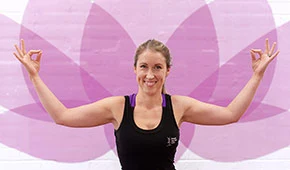
Treating fibromyalgia through Yoga
The word “Fibromyalgia” stems from New Latin, “fibro”, meaning fibrous tissue (connective), “myo” meaning muscle, and “algos” meaning pain. The term fibromyalgia describes the symptoms precisely: “pain of the muscle and connective tissue”.
Fibromyalgia was first described by the American College of Rheumatology in 1990. It is characterized by chronic, widespread pain of unknown origin. It’s a chronic pain condition that affects up to 15 million people in the USA, and the prevalence of fibromyalgia amongst Western European population is 6.6%.
Symptoms of fibromyalgia include:
• widespread musculoskeletal pain
• fatigue
• sleep disturbances (waking unrefreshed)
• paresthesia (tingling, pricking, chilling, burning, or numb sensation on the skin)
• anxiety
• depression
• irritable bowel syndrome (IBS)
• morning stiffness
These symptoms have a negative impact on the psychological health of a patient and may lead to poor quality of life. Fibromyalgia patients may experience difficulty in managing these symptoms which may lead to an increased mortality rate.
There is no gold standard radiology or laboratory test to confirm fibromyalgia diagnosis. Diagnosis is based on a history of widespread, chronic pain and acute tenderness or pain on local pressure applied to at least 11 of 18 tender points. These diagnostic criteria were agreed upon in 1990 by the American College of Rheumatology.
The widespread symptoms of fibromyalgia have patients seeking extensive treatment, with an annual cost of care greater than 20 billion US dollars. The average health care costs for fibromyalgia patients is three times greater than people without fibromyalgia, based on the same age and sex. In the United States up to 15% of fibromyalgia patients are on some form of disability, Medication may be used for pain, anxiety, depression and sleep disturbances. Pharmacological interventions include nonsteroidal anti-inflammatory drugs, opiods, antidepressants and anticonvulsants. According to J W Carson, drug therapies are only 30% affective in symptom relief and 20% effective in improving function. The use of these medications also has the risk of side effects or dependencies.
Yoga and Fibromyalgia
In most western countries yoga has become synonymous with asana practice. Yoga should be a lifestyle. In the Yoga Sutras, Patanjali alludes that humanity creates their own suffering, by the belief that we create our own reality. This suffering is interwoven into our lives because of our attachment to our self identity (ego). In order to end this suffering we must dissolve the ego, so that attachment is destroyed. That is the path of yoga set out in Patanjali’s eight limbs.
Practice of the eight limbs of yoga ultimately leads to Samadhi, where one becomes one with the universal spirit. BKS Iyengar said that it is the ultimate goal of yoga to yoke or unify all aspects of being.
J W Carson suggests that fibromyalgia patients need a comprehensive treatment strategy to address all of the symptoms to ultimately improve quality of life. Group Yoga classes may include themes or discussions on the eight limbs of yoga.
For example, Ahimsa (non-violence) can be applied to teach kindness and compassion to oneself during asana practice. It is important to let go of the idea of proving to others that they are really trying to get better by pushing through the pain. Careful and kind practice is towards oneself, respecting physical limitations is important to avoid aggravating symptoms. This may also cultivate kindness towards others.
Satya (truth/truthfulness) will cultivate acceptance of the diagnosis of fibromyalgia and letting go of the idea of returning to a pain-free, perfect body. Whereas Asteya (non-stealing) relates to the disease stealing your identity. Ultimately fibromyalgia patients may find their identity in their diagnosis. Cultivating a sense of self is important.
The act of abstinence, or Brahmacharya, can cultivate a sense of respect for, and knowledge of, your own limit, in regards to physical activity. Pain may not be the best indicator, because of the altered physiology. Here the comfort and depth of the breath will be of greater importance in measuring physical exertion.
Aparigraha (non-possessiveness) may cultivate a sense of serving others, this may enable fibromyalgia patients to feel needed and contribute to feelings of self-worth.
Santosa, or contentment with one’s circumstances, resonates with mindful living. Mindfulness advocates greater presence of mind or being in the moment, acceptance of circumstances (pain for example) and the willingness to learn from these experiences. In turn, Tapas (self-discipline) may cultivate the discipline that will be needed for a daily practice, and Svadhyaya (self-study/reflection) may cultivate coping strategies. Healthy coping is of utmost importance considering that fibromyalgia is a chronic condition.
Asana practice holds many physical benefits including increased range of motion, strength and endurance and improved balance. A regular practice may develop a sense of accomplishment and ultimately well being for a fibromyalgia patient.
Breathing exercises like Pranayama, especially (Nadi Shodana, Sheetali, Sheekari and Bramari) stimulate the parasympathetic nervous system. Deep breathing decreases feelings of anxiety and aids in pain regulation.
A regular meditation practice will calm the mind. A fibromyalgia patient could meditate on a mantra of their own creation (“I am strong” or “I am in control of my own body”) that may encourage acceptance and healthy coping strategies.
15 Minute Practice: Yoga for a Healthy Mind
The pranic body should also be considered. The practice of Shatkarma (six yoga cleansing strategies) aids in purifying the body (physical and pranic) to achieve higher states of consciousness. Sharkarma includes asana and pranayama, mantra chanting, kriyas and a sattvic diet.
Combining the practices described has the potential to meet the comprehensive treatment sought by fibromyalgia sufferers and their caregivers.
Yoga and Fibromyalgia Medical Studies
In the last decade more research has been done to determine the potential benefits that yoga may have for patients with fibromyalgia. GD Da Silva conducted a study comparing yoga with and without Tui Na (traditional eastern massage technique) treatment. Thirty-three patients, aged 25-60, were enrolled in the study (17 patients were assigned to receive Tui Na treatment in conjunction with the yoga practice). The therapy consisted of eight weekly, one on one sessions, of 50-minute duration. Gentle single plane movements were included in the asana practice, followed by seven minutes of diaphragmatic breathing, whereafter 15 minutes of relaxation techniques ended the session. After the class different texts on yoga philosophy were read.
The Tui Na technique was applied to patients assigned to the group during their relaxation phase. Both groups showed statistically significant improvement in FIQ (Fibromyalgia Impact Questionnaire) and VAS (visual analogue scale) scores. After completion of the eight-week program, participants that received additional Tui Na treatment reported lower VAS scores. This difference was not maintained at the four week follow up. These results demonstrated that yoga is a valid treatment option for fibromyalgia patients. Tui Na had greater short term benefits, but this was not maintained with follow up. This implies that passive therapy, such as massage, negatively influence treatment outcome, by having short term benefits that are not sustained. This may lead to unrealistic treatment expectations for fibromyalgia patients. The continued improvement in pain levels of the group that did not receive the Tui Na treatment may be explained by the recommendation to maintain a regular yoga practice. This active participation resulted in greater independence, better coping and ultimately improvement.
Yoga of Awareness was used as an intervention in a randomized control trial. This program combined gentle yoga asana, meditation, pranayama and yoga based coping strategies. The study consisted of 53 women, older than 21, meeting the American College of Rheumatology’s diagnostic criteria. Participants were randomly assigned to start the yoga program immediately or waitlisted for three months (control group). The yoga intervention consisted of an eight-week program, with once-weekly 120 minutes group classes. The classes consisted of 40 minutes gentle asana, 25 minutes mindfulness meditation, 10 minutes pranayama, 20 minutes presentations of yogic principles for optimal coping and 25 minutes group discussion. Repetitive and eccentric contractions were minimized to reduce micro trauma to muscles, slow transitions were used to aid in autonomic nervous regulation. Participants were provided with equipment and a DVD to encourage a home practice. Improvement in pain, fatigue, stiffness, sleep, depression, memory, anxiety, tenderness, balance and strength were reported after intervention.
In another study called Managing Fibromyalgia with Yoga and Meditation, J Hennard recruited 11 individuals, between the ages of 27-70 years, to participate in a Yoga for fibromyalgia workshop. The workshop consisted of once weekly group sessions, for eight weeks, 75 minutes in duration. Sessions included 10 minutes pranayama, 15 minutes group discussion, 35 minutes asana practice and 15 minutes Savasana and meditation. Props were used and adjustments made where necessary. Students received a handout of each class to encourage a home practice. FIQ scores after an eight week intervention showed significant improvement in the overall severity of symptoms.
These are just a few of the studies that have been carried out on yoga as a treatment for fibromyalgia, and all of the studies to date suggest yoga can have a profoundly positive impact on the quality of life of someone living with fibromyalgia.
In Conclusion
Yoga offers a variety of benefits for a person diagnosed with fibromyalgia. Yoga is a comprehensive option to address the symptoms of fibromyalgia, without possibly dangerous side effects. A consistent yoga practice is an active treatment option, which gives a patient with fibromyalgia strategies to manage their symptoms within their day to day life. These coping mechanisms gives a patient back their independence and sense of control. A group class setting can be a wonderful social support network, where patients can share their experience and feel less isolated.
The safety of yoga far out weighs the possible side effects of pharmacological treatment. Medication can be limited to the lowest possible dosage with the active participation of a patient in their own treatment. This will be safer and more cost effective, for both the patients and the respective health care system.
Carli van Dyk
Yoga Teacher and Himalaya Yoga Valley Level II Graduate
Carli is the founder of Align Yoga, South Africa and a Himalaya Yoga Valley Level II graduate. She’s passionate about guiding people on their own yoga journey and says “There is enough suffering out there, whatever is within our power to control, we should, yoga is my strategy of choice”. Carli loves to merge her physiotherapy background with yoga and believes the body is an amazing vehicle capable of healing and that rehabilitation should be sustainable for each individual.
Cali teaches regularly at I teach at Yoga Harmony in Pretoria, South Africa
You can follow Carli’s teaching on her Instagram on her Facebook or by visiting her website www.alignyoga.co.za






